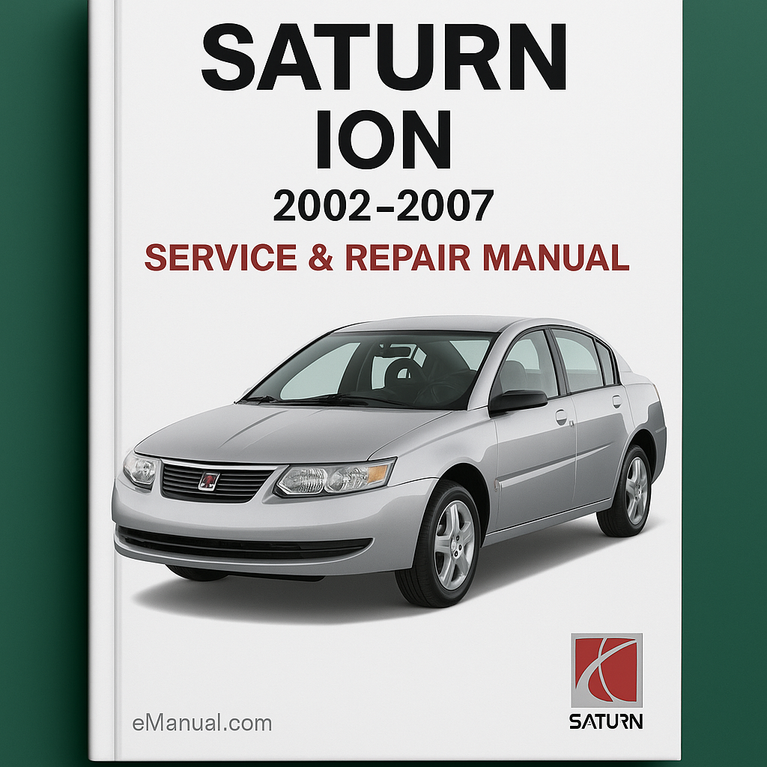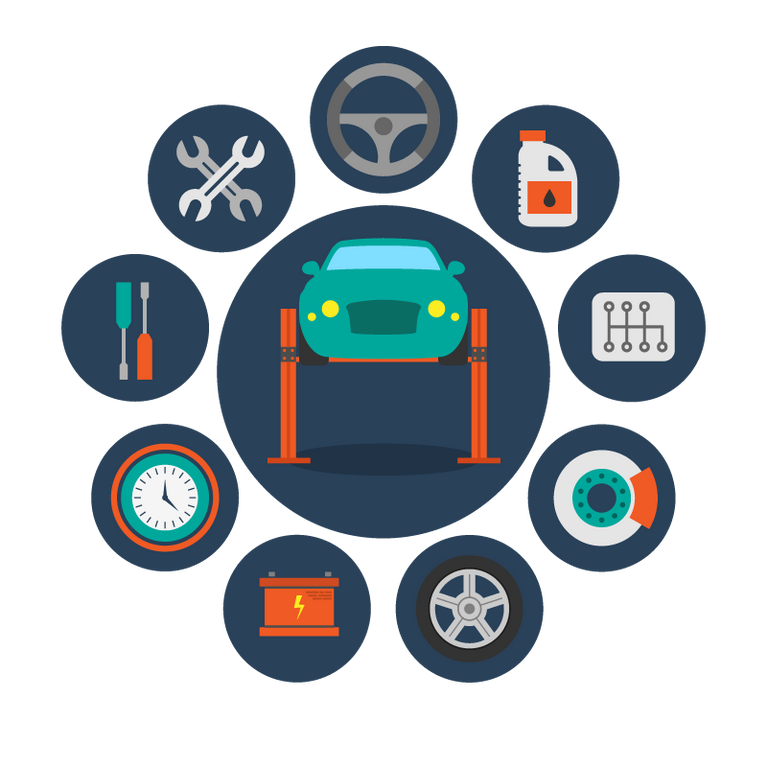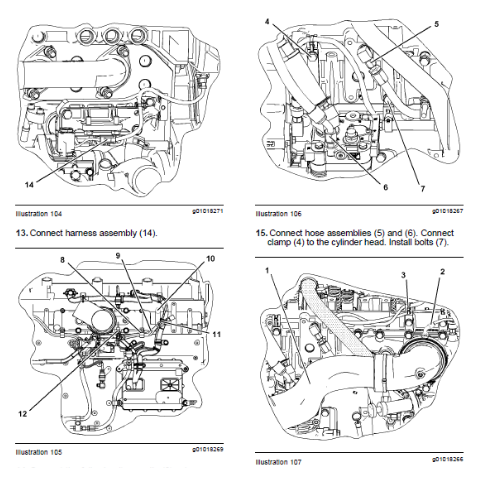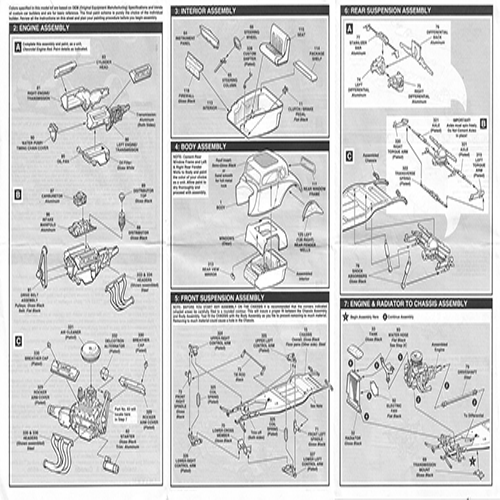Vehicle Segment:
Compact Car
Brand Philosophy:
Saturn was positioned as a distinct, customer-focused brand within General Motors, emphasizing unique design (polymer body panels), value, and a different retail experience.
Competitors:
Honda Civic, Toyota Corolla, Ford Focus, Chevrolet Cavalier/Cobalt, Hyundai Elantra, Mitsubishi Lancer.
Vehicle Highlights:
Distinctive styling, polymer body panels (dent-resistant), European-inspired chassis dynamics (for some models), affordable price point.
User Benefit:
Empowers owners and independent mechanics to perform a wide range of maintenance and repair tasks, saving money compared to dealership labor costs, while ensuring quality and accuracy.
Primary Coverage:
All aspects of service, repair, and maintenance for the Saturn Ion (2002-2007 models).
Specific Regions Covered:
North America (primarily US and Canada)
Estimated Page Count:
Varies by specific edition, but typically 1000+ pages for comprehensive service manuals.
Type:
Service and Repair Manual
Purpose:
DIY repairs, professional mechanic use, dealership service.
Delivery Method:
Instant Download
Powertrain:
Engine Mechanical, Engine Control System, Fuel Service, Emission Control, Intake/Exhaust/Cooling, Lube, Ignition, Starting, Charging, Automatic Transmission, Manual Transmission, Clutch.
Chassis:
Transfer Case/Propeller Shaft (if applicable), Drive Shaft, Differential, Axle, Suspension, Tire & Wheel, Brake Control, Brakes, Parking Brake, Steering Column, Power Steering.
Body And Electrical:
Air Conditioning, Supplemental Restraint System (SRS), Seat Belt, Engine Immobilizer, Cruise Control, Wiper & Washer, Door Lock, Meter/Audio/Visual, Horn, Windshield/Glass/Mirror, Instrument Panel, Seat, Engine Hood/Door, Exterior & Interior, Electrical System, Multiplex/CAN Communication.
Maintenance:
Scheduled maintenance, fluid checks and changes, filter replacements, tire rotation, battery service.
Repair And Diagnostics:
Step-by-step repair procedures, component removal and installation, troubleshooting guides, electrical system diagnostics, wiring diagrams.
Depth:
Comprehensive, covering everything from basic fluid changes to complete engine and transmission rebuilds, including detailed diagnostic trees and electrical schematics.
Compatibility:
All PC-based Windows operating systems, Mac, and Linux.
Printability:
All pages are printable for hard copy reference.
Binding:
Digital (N/A - printable PDF)
Paper Quality:
Digital (N/A - printable PDF)
Required Software:
WinZip (or equivalent decompression utility) and Adobe PDF Reader.
Base Engine:
2.2L L61 Ecotec I4
Base Engine Displacement:
2198 cc (2.2 Liters)
Base Engine Horsepower:
140 hp @ 6000 rpm
Base Engine Torque:
145 lb-ft @ 4400 rpm
Performance Engine:
2.0L LSJ Ecotec Supercharged I4 (Red Line and Ion Red Line models)
Performance Engine Displacement:
1998 cc (2.0 Liters)
Performance Engine Horsepower:
205 hp @ 5600 rpm
Performance Engine Torque:
200 lb-ft @ 4400 rpm
Fuel Delivery:
Sequential Electronic Fuel Injection (SEFI)
Fuel Type:
Unleaded Gasoline (87 octane recommended for naturally aspirated, 91+ octane for supercharged models)
ECU Type:
GM's Engine Control Module (ECM), often referred to by its specific GM platform identifier (e.g., P12 for this generation).
Length:
Approximately 178.7 inches (Sedan) / 179.4 inches (Quad-Coupe)
Width:
Approximately 68.0 inches
Height:
Approximately 55.7 inches (Sedan) / 55.6 inches (Quad-Coupe)
Curb Weight:
Approximately 2700-2900 lbs, varying by trim and options.
Gross Vehicle Weight Rating:
Typically around 3700-3800 lbs.
NHTSA Frontal Crash Rating:
Frontal driver: 4 stars; Frontal passenger: 5 stars (for most models and years, refer to specific year/model data).
NHTSA Side Impact Rating:
Side driver: 4 stars; Side rear passenger: 5 stars (for models equipped with side airbags).
Standard Safety:
Anti-lock Braking System (ABS) - typically standard on most trims, front airbags, power-assisted steering.
Optional Safety:
Traction Control System (TCS), available side-impact airbags, available front seat-mounted side-impact airbags.
Restraint System:
Front and rear seat belts with pretensioners, LATCH (Lower Anchors and Tethers for Children) system, front airbags, optional side-impact airbags.
Body Structure:
Reinforced safety cage construction, energy-absorbing steering column, polymer outer body panels (designed for low-speed impact resistance and easier repair).
Audio System:
Standard AM/FM stereo with CD player, optional premium sound systems, steering wheel audio controls available on higher trims.
Display:
Central display for audio and climate controls, often with digital readouts.
Cruise Control:
Standard or optional depending on trim level.
Onstar:
Available on select models/trims, providing telematics and emergency services.
Gauge Cluster:
Includes tachometer, speedometer, fuel gauge, engine temperature gauge, and various warning lights. Some models feature a centrally located gauge cluster.
Oil Change Interval:
Typically every 7,500 miles or 6 months, or as indicated by the Oil Life Monitoring System (OLMS).
Air Filter Replacement:
Every 30,000 miles or as needed, depending on driving conditions.
Spark Plug Replacement:
Iridium spark plugs typically last 100,000 miles.
Engine Oil:
SAE 5W-30 Synthetic Blend or Full Synthetic (API SN or newer).
Coolant:
GM Dex-Cool® (Orange) Long-Life Antifreeze/Coolant (50/50 mix with distilled water).
Transmission Fluid Automatic:
Dexron®-VI Automatic Transmission Fluid (ATF).
Transmission Fluid Manual:
GM Manual Transmission Fluid (MTF) or equivalent GL-4 gear oil.
Brake Fluid:
DOT 3 or DOT 4 Brake Fluid.
Power Steering Fluid:
GM Power Steering Fluid or Dexron®-VI ATF.
Common Problems:
Ignition coil failures, catalytic converter issues, power steering pump leaks/failure, minor electrical gremlins, ABS sensor issues, dashboard delamination (especially on early models).
Supercharged Engine Specific:
Supercharger belt wear, intercooler clogging, potential for piston ring land failure under extreme stress if not maintained properly.
Parent Company:
General Motors (GM)
Brand Discontinuation Year:
2010
First Generation Introduction:
2003 model year (based on GM's Delta platform).
Key Updates:
Introduction of the supercharged Ion Red Line in 2004, refinements in suspension and interior for 2005, mild styling refresh for 2006.
Manufacturing Plant:
GM's Lordstown Assembly Plant, Ohio, USA.
Total Production Run:
Approximately 550,000 units across all model years.



